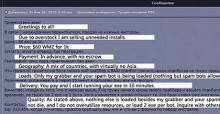ZeuS Trojan author in with spam kingpins
The cybercrime underground is expanding each day, yet the longer I study it the more convinced I am that much of it is run by a fairly small and loose-knit group of hackers. That suspicion was reinforced this week when I discovered that the author of the infamous ZeuS Trojan was a core member of Spamdot, until recently the most exclusive online forum for spammers and the shady businessmen who support the big spam botnets.













































































